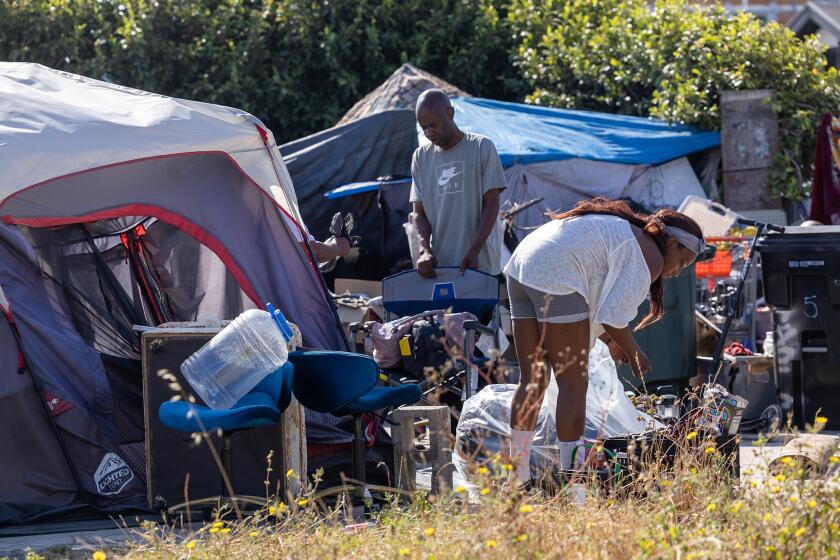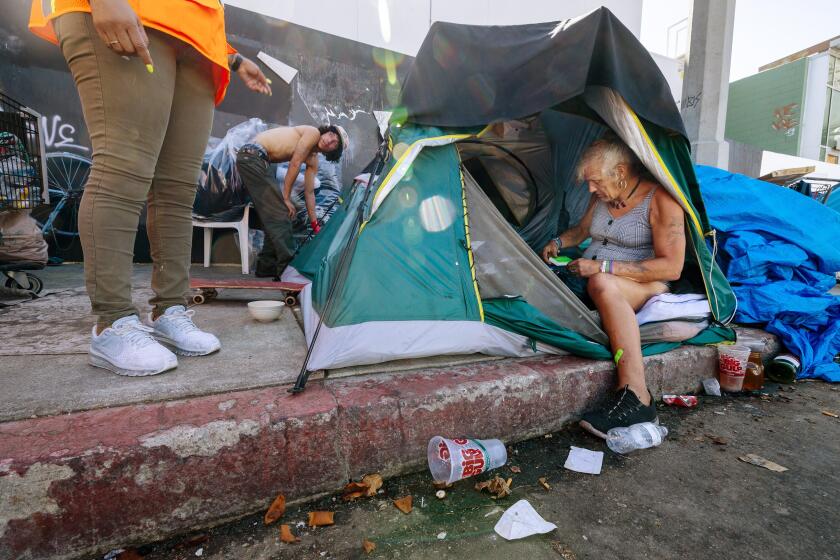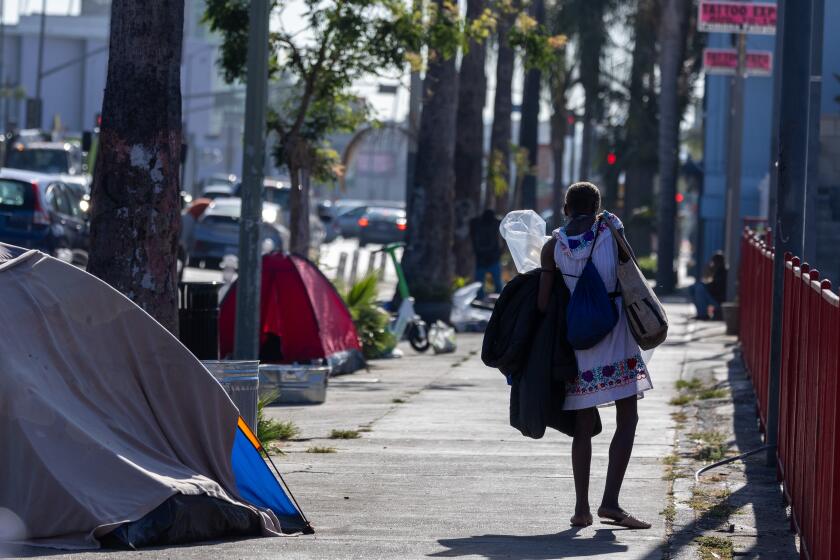The under-the-radar proposal to end homelessness in Los Angeles for $20 billion

- Share via
- To end homelessness, Los Angeles would need to more than double its projected spending over the next decade, a draft city analysis says.
- The proposal would fund tens of thousands of new supportive and affordable housing units. There’s no timeline for its formal release.
It would cost $20.4 billion to end homelessness in Los Angeles in a decade, a price tag requiring local, state and federal governments to more than double their spending on the problem, according to a draft budget analysis from city housing officials.
The money would produce 36,000 permanent housing units for homeless residents with chronic health needs and build or subsidize 25,000 additional apartments for very low-income residents. The proposal assumes the city maintains nearly 17,000 beds in shelters and other interim housing locations through 2029 before ramping down.
If implemented, the analysis projects homelessness to decline annually before reaching what’s known as “functional zero” by the end of 2032. That means episodes of homelessness are rare and brief and anyone who needs a shelter bed — the city and private missions and other providers would maintain 6,000 per the analysis — can access one.
There are about 45,000 people who are homeless in the city of Los Angeles, 29,000 of whom are unsheltered, according to the most recent point-in-time count of the homeless population.
There’s no timeline for the formal release of the analysis, said Ann Sewill, the Housing Department’s general manager. The Times obtained a draft version, written in January, through a public records request. The draft provides a comprehensive look at spending needs. It delineates funding from the city, county, state and federal governments, projects the new homes that would be created and estimates what the sheltered and unsheltered homeless population would be, all on an annual basis.
“The purpose was to provide a thorough, detailed, data driven analysis of the housing resources, needs, and housing gap, and determine what mix of investments could close the gap over 10 years,” Sewill wrote in notes to a draft presentation on the proposal.
The 2024 homeless count found the number of people living on Los Angeles city and county streets declined after five years of increases.
While not final, the documents provide a window into the vast scale of L.A.’s homelessness problem and the enormous financial commitment city officials believe is needed to resolve it. The proposal projects $7.9 billion in homelessness spending over the next decade based on existing funding streams, leaving a $12.5-billion gap.
Homelessness continues to be the top concern listed by Angelenos in polls, and Mayor Karen Bass has dedicated much of her initial term in office to the issue, most prominently through an encampment clearing and shelter program called Inside Safe.
The mayor and other local leaders soon will face even more pressure to address homelessness with the region holding World Cup events in 2026 and the Olympics two years later. Bass has promised that unlike leaders in prior host cities, she will not ship homeless people out of L.A. in advance of the Games.
Zachary Seidl, a Bass spokesperson, declined to respond to a list of questions from The Times about the proposal, noting that it was a draft.
“Since taking office, the mayor has broken with the status quo and is urgently bringing people inside while preventing people from falling into homelessness in the first place and building more housing to house people permanently,” Seidl said in a statement.
The new approach contrasts with the city’s major homelessness initiative in 2016 when it joined with community groups in backing Proposition HHH, a $1.2-billion bond to fund 10,000 supportive housing units. That goal fell well short of the number of units needed to house a homeless population that was much smaller then than it is now.
This analysis is more than three years in the making, originating with a request by then-Councilmember Mark Ridley-Thomas, who chaired the council’s housing and homelessness committee. Last year, with the report stalled, Councilmember Nithya Raman, the current committee chair, made her own call for an analysis.
Raman said in an interview that the effort is necessary to prioritize city spending toward successful programs. Rather than simply grabbing on to funding that becomes available, such as COVID-19 relief dollars from the federal government and money for motel conversions from the state, the proposal could help elected officials at all levels of government make strategic decisions, she said.
“We have been making a lot of investments in shelter and in housing,” Raman said. “Those investments have often been made in a very ad hoc manner.”
Raman said she’s waiting on the final version to examine its assumptions in depth, but understood that any proposal would be expensive. There could be opportunities to cut costs, she said, citing data from interim housing programs showing that temporary housing subsidies are helping more people exit homelessness than originally believed. The program’s success could alleviate some of the projected need for more expensive permanent supportive housing construction, she said.
Even if the city cannot raise what’s needed to end homelessness, she said, the city has already shown that focused investment can better the situation. Raman credited Bass’ Inside Safe and related initiatives for the 10% reduction in the city’s unsheltered population this year.
“There has been homelessness in Los Angeles for a very, very long time,” she said. “Functional zero is a goal. But I think any of the work that we do to go steadily towards that goal will result in significant improvements for Angelenos.”
Mayor Karen Bass says that unlike previous cities that hosted the Summer Olympics, Los Angeles will not resort to draconian measures to address homelessness.
As drafted, the analysis does not propose new programs to address homelessness. Rather, it assumes the city scales up its existing efforts, such as Inside Safe and the building of permanent supportive housing. It incorporates thousands of new units of interim and permanent housing the city has committed to provide in its settlement of a lawsuit filed by the L.A. Alliance for Human Rights, a group of business owners and residents who alleged the city and county were failing their duty to address homelessness. It also includes about 3,450 new mental health beds the county has agreed to open under the settlement.
Just sustaining existing homelessness spending could be challenging as local and state budgets flush with revenue during the height of the COVID-19 pandemic now have turned to deficits.
Nearly a third of the funding gap is money the city says is needed from the federal government, largely through additional vouchers to pay operating subsidies for supportive housing. The increased federal assistance is among the most uncertain parts of the proposal, with the outcome of November’s presidential election playing a heavy role. Vice President Kamala Harris’ housing plans, which call for more funding for low-income housing, are friendlier to the city than former President Trump’s.
The city’s share of the spending deficit under the proposal is $2.8 billion. It anticipates closing that gap via a tax increase that would go before voters — either citywide or countywide — in 2026.
Both L.A. County and the state must provide more dollars as well.
The proposal assumes the county continues paying for social services for homeless residents through a quarter-cent sales tax hike approved by voters in 2017. The tax is set to expire in 2027. Homelessness advocates have placed Measure A, a permanent half-cent sales tax increase, on the November ballot to replace and expand the funding. If it’s approved, additional money could go toward the county’s $1.6-billion portion of the overall gap identified in the proposal.
A measure on the November ballot that would double the county’s quarter-cent homeless sales tax is leading in an early poll of L.A. County voters but not with enough support yet to pass.
The state, for its part, would need to increase its funding by $3.5 billion, primarily to fill capital costs for very low-income and supportive housing.
Sewill said in notes to her presentation that a detailed homelessness funding plan could help local leaders advocate for resources when lobbying federal and state officials.
“We must do more, and we cannot do it alone,” Sewill wrote.
Public officials and civic leaders are working on a similar analysis to estimate the cost and programs needed to end homelessness across L.A. County, said Miguel Santana, president and chief executive of the California Community Foundation and one of the leaders of the effort.
About 75,000 people are homeless on any given night in L.A. County, per the most recent survey, with the city’s population making up 60% of the figure.
The countywide proposal will integrate the city’s finalized effort, Santana said. Its purpose too, he said, will be to provide the public with a road map toward resolving the homelessness problem in a decade.
“What has been missing in all of this is an endgame,” Santana said.
Times staff writer David Zahniser contributed to this report.
More to Read
Sign up for Essential California
The most important California stories and recommendations in your inbox every morning.
You may occasionally receive promotional content from the Los Angeles Times.











